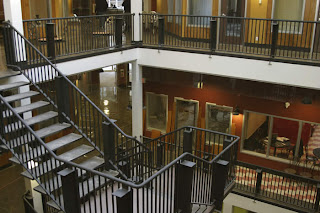
Image credit: Leszek Wyczolkowski, 2007, Courtesy of SNAP Gallery
As you take in SNAP’s inner gallery from left to right, Polish Canadian artist Leszek Wyczolkowski’s graphics build upon an intensity of restraint. From earlier works dating back to early 2000 to recent works completed at the Banff Centre for the Arts, Wyczolkowski’s Searching for Balance reflects a convergence of two worlds: one world of stoic geometry and the other of organic movement.
Sequestered blocks of embossed squares reach out for a dualism in balance; offsetting black and white symmetry with shape, texture and eventually primary colours, the eye wanders from block to block, guided by an unbound rhythm at play between the squares (which in themselves resemble windows into separate worlds in motion).
There is a motion occurring within each work, and in following this motion, you begin to see the artist’s search for balance.
Just as the geometric cleanliness of a work sets the eye at awe, the next graphic introduces an organic element, from the bark of a tree to the stamp of a cabbage—natural shapes and textures strike a new balance.
The influence of Taoism emerges halfway through the show, where the simplicities of movement and containment begin factoring into the overall experience of the work. There is no one way to view the works, but the graphics would work best as a whole, stretched out side by side in an evolving succession of logic and intuition.
The introduction of solid colours also brings a surprisingly modern contrast to the former works, which though formally quite similar, take on a new dimension on the visual plane with the addition of colour. A solid square of yellow, offset by a square panel of thick vertical two-tone stripes—in itself a strong pattern—is weighed and balanced by an organic rendering of tree bark. There is a witty harmony running throughout the pieces that tempers both the emotional and logical side of perspective.
Wyczolkowski, an internationally recognized artist who was onsite during the opening of his exhibition, mused about the balances unfolding throughout his works.
“There are layers,” he says pointing to one of his newer pieces, “at odds with one another. There is something very basic, but strong about each square.” Tracing a line beyond its embossed border with his finger, he reflects, “How does the line continue here and how does it relate to the other squares?”
Wyczolkowski asks these questions with earnest intention, as they are questions for himself as much as they are for his viewers.
(First published in Vue Weekly, September 26 - October 2, 2007 Print and Online)
+Kindregan.jpg)
+Louter.jpg)








